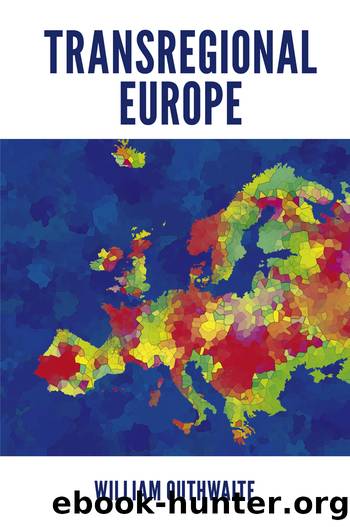Transregional Europe by William Outhwaite

Author:William Outhwaite [Outhwaite, William]
Language: eng
Format: epub
Tags: Social Science, General, Anthropology, Physical, Sociology
ISBN: 9781787694934
Google: c8HZDwAAQBAJ
Publisher: Emerald Group Publishing
Published: 2020-04-13T02:46:11+00:00
Chapter 6
Eurasia: Complement or Competitor?
â¦All Europeans ought to see, on a map of Russia, their little land as a frayed, nervous territory far out to the west (Walter Benjamin, âMoscowâ, 1927)196
Eurasia as a geographical region forms the background to the discussion of Europe in this book. I fully agree with the approach taken by the social anthropologist Chris Hann, who stresses the broad geohistorical similarities across the whole continent, in opposition to the orientalising conceptions of Europeans attempting to draw specious dividing lines between Europe and Asia and, as Hann (2016: 1) puts it, âregarding them as equivalent continents.â197 One important feature is the mobility of goods and ideas (such as the world religions) along the terrestrial trade routes which are now being revived with the rise of China. Russia, as we shall see, appears on both sides of this argument, practising internal colonialism as far as the Pacific and creating what look like European cities, while it also sometimes fetishised the division between Europe and Asia, as in the column in the Urals between the provinces of Perm and Tobolsk, where exiles said goodbye as they continued into Siberia.198 As well as continuing the Tsarist practice of exile, the USSR imposed what became, as Hann notes, a pan-Eurasian ideology and practice of Marxism-Leninism-Maoism.199 The political break between China and the USSR in the early 1960s was cemented by the latter's demise in 1991, with China continuing a bizarre amalgam of Marxism (and Communist Party rule) with capitalism.200
The European interface with countries and regions in Asia has been a topic in some of the planning exercises discussed above. The focus of this chapter is the integration process in Eurasia more narrowly defined, centred on Russia. This imitates in some ways the European integration process, as well as intersecting with it along the borders of the European Union (EU). Here, macro-regional planning has been concentrated mainly on extractive industries and transport, with Europe heavily dependent on energy from Russia and consumer goods from China, which are beginning to be transported by land on the âSilk Roadâ via Moscow or the âSilk Windâ via Kazakhstan, Azerbaijan and Turkey, as well as the more established routes by sea.201 These two rail routes illustrate one of the tensions in Eurasia, with one passing through Russia and the other skirting it, for reasons which may be political as well as technical. (The routes of the oil and gas pipelines further west from Russia are more clearly politically motivated.)
As in the case of European integration, there is a Eurasian ideology which picks up earlier themes in specifically Russian cultural and geopolitical self-reflection (Laruelle, 2008). These preceded the baptism of Eurasia by Erhard Suess, the London-born Viennese geologist who coined the term in the late 1880s. In Russia, the theme was taken up by Nikolai Danilevsky and later Vladimir Lamansky, who spoke of the âAsiatic-European continent.â In 1915 the geographer Veniamin Semenov-Tian-Shansky referred to âRussian Eurasia,â arguing for the development of the geographical centre of the Empire (Bassin, 2017: 212â13).
Download
This site does not store any files on its server. We only index and link to content provided by other sites. Please contact the content providers to delete copyright contents if any and email us, we'll remove relevant links or contents immediately.
Adding Value to Policy Analysis and Advice by Claudia Scott; Karen Baehler(457)
Sociological Perspectives of Health and Illness by Constantinos N. Phellas(446)
Race and American Political Development by unknow(443)
American Government and Politics Today by Steffen W. Schmidt Mack C. Shelley Barbara A. Bardes(432)
Human and Global Security : An Exploration of Terms by Peter Stoett(426)
Control Of Oil - Hardback by Kayal(409)
Entrepreneurship Education and Training: The Issue of Effectiveness by Colette Henry Frances Hill Claire Leitch(372)
The Catholic Church and European State Formation, AD 1000-1500 by Jørgen Møller(357)
Materializing the Middle Passage by Jane Webster;(357)
The World According to China by Elizabeth C. Economy(345)
Left Is Not Woke by Susan Neiman(329)
Theories of Counseling and Psychotherapy: A Case Approach by Nancy L. Murdock(318)
Turkey's Relations with the West and the Turkic Republics: The Rise and Fall of the Turkish Model by Idris Bal(315)
Cross-Cultural Child Development for Social Workers by Lena Robinson(312)
Advances in Child Development and Behavior, Volume 37 by Patricia J. Bauer(298)
Japan's Ainu Minority in Tokyo by Mark K. Watson(297)
Laboratory Life by Bruno Latour(294)
Beyond Service: State Workers, Public Policy, and the Prospects for Democratic Administration by Greg McElligott(285)
The Oxford Handbook of Museum Archaeology by Stevenson Alice;(276)
